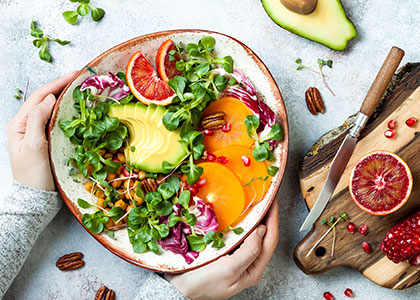
8 Tips for a Delicious Salad
By Team Reboot
Any great — and nutritionally sound — salad will include greens, veggies, protein and healthy fats. But there’s plenty of room to play around in that structure.
So if your mix of iceberg lettuce and crunchy carrots is feeling a bit tired, take a look at these simple strategies that can add new life to your salad routine!
Think color
While it may be a bit of a cliche, there’s truth to it: We eat with our eyes first. So a salad that’s made up of a variety of shades of green can feel a little bit dull. Add bright pops of color — you can add diced yellow and orange peppers, red radishes, or yellow squash.
Along with being aesthetically pleasing, there are lots of nutritional benefits to eating the rainbow
Add fruit
Do you pop in the same five veggies every day? Try going beyond this base, and incorporating fruit. Cubed apples can provide a satisfying crunch, while citrus gives a jolt of acid. Pomegranate seeds are a beautiful and tasty addition, too.
Incorporate seasonal items and something new
Throughout the calendar year, the produce in season will shift. Your salad should shift with it, featuring root vegetables and citrus in winter months and green beans and corn in warmer months. Eating seasonally is good for your health — and your wallet.
Plus, try new vegetables and other add-ins throughout the year so your salad remains exciting and fresh.
Cook veggies
Raw veggies are great, but don’t forget that a roasted, steamed or sauteed vegetable can change up the taste and texture of your salad.
Mix up your greens
Don’t go for lettuce every day. Try all sorts of greens in your salad, such as kale, arugula, microgreens, spinach and more. Here are seven greens to eat, juice and blend.
Tip: you can also include fresh herbs in the mix!
Don’t forget grains
Try quinoa, wild rice and other whole grains. Not only are they filling, but they provide essential nutrients and a source of fiber, which helps keep your digestive system humming along.
And always incorporate protein and fat
If you want your salad to be satiating and serve as a meal, you’ll need to include healthy fats (think: avocado and nuts) as well as sources of protein, such as tofu, cheese, eggs, vegan meats, legumes and other plant proteins.
Get inspiration from recipes
While you can always wing it when it comes to your salad prep, a recipe can also be a good source of inspiration. Here are some of our favorites:
- Spiced Cauliflower Salad with Pomegranate
- Grilled Pear Walnut Salad
- Colorful Chopped Asian Kale Salad
- Tropical Avocado, Papaya & Ginger Salad
- Warm Roasted Vegetable Quinoa Salad
- Arugula, Mango & Cashew Salad
- Vegan Kale Caesar Salad
- Arugula, Avocado & Grapefruit Salad
- Bell Pepper, Corn and Avocado Salad
- Hearty Spring Salad with Spinach-Pesto Dressing
- Grilled Zucchini Salad